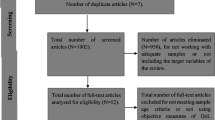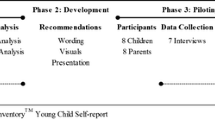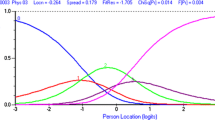Abstract
Purpose
To review the use of quality of life (QOL) measures utilised in children and youth with autism spectrum disorder (ASD).
Methods
Relevant articles were identified through database searches using MEDLINE, CINAHL Plus with Full Text and SPORTDiscus with Full Text via EBSCO Health Database, PsycINFO and ProQuest Health and Medicine (from 2000 to May 2013). Original research articles were included that measured QOL in children and youth with ASD aged 5–20 years. Searches were limited to articles from peer-reviewed journals, in English or German, and those available in full text.
Results
The search identified 1,165 titles and 13 met the inclusion criteria. The review identified a number of QOL measures used in children and youth with ASD, with the most common one being the Pediatric Quality of Life Inventory™ (PedsQL). QOL measures using self-reports were uncommon, and the reliability and validity of QOL measures were not sufficiently reported for this population. Large discrepancies in QOL scores were found between self-reports and proxy-reports. Despite the differences in study design and methodological quality, there was consistency in the results among studies; children and youth with ASD provided lower QOL scores, particularly for social domains, compared to their healthy counterparts.
Conclusions
The PedsQL is likely to be an appropriate QOL measure for use in children and youth with ASD. Future research should focus on examining the appropriateness, reliability and validity of QOL self-reports for use in this population.

Similar content being viewed by others

References
Filipek, P., Accardo, P., Baranek, G., Cook, E, Jr, Dawson, G., Gordon, B., et al. (1999). The screening and diagnosis of autistic spectrum disorders. Journal of Autism and Developmental Disorders, 29(6), 439–484. doi:10.1023/a:1021943802493.
Ozonoff, S., Goodlin-Jones, B. L., & Solomon, M. (2005). Evidence-based assessment of autism spectrum disorders in children and adolescents. Journal of Clinical Child and Adolescent Psychology, 34(3), 523–540.
American Psychiatric Association. (2000). Diagnostic and statistical manual of mental disorders, fourth edition, text revision (DSM-IV-TR) (4th ed.). Washington, DC: American Psychiatric Association.
American Psychiatric Association. (2012). DSM-5 proposed criteria for autism spectrum disorder designed to provide more accurate diagnosis and treatment. http://www.dsm5.org.
Kamp-Becker, I., Schröder, J., Muehlan, H., Remschmidt, H., Becker, K., & Bachmann, C. J. (2011). Health-related quality of life in children and adolescents with autism spectrum disorder. Zeitschrift für Kinder-und Jugendpsychiatrie und Psychotherapie, 39(2), 123–131. doi:10.1024/1422-4917/a000098.
Brereton, A. V., Tonge, B. J., & Einfeld, S. L. (2006). Psychopathology in children and adolescents with autism compared to young people with intellectual disability. Journal of Autism and Developmental Disorders, 36(7), 863–870. doi:10.1007/s10803-006-0125-y.
Simonoff, E., Pickles, A., Charman, T., Chandler, S., Loucas, T., & Baird, G. (2008). Psychiatric disorders in children with autism spectrum disorders: Prevalence, comorbidity, and associated factors in a population-derived sample. Journal of the American Academy of Child and Adolescent Psychiatry, 47(8), 921–929. doi:10.1097/CHI.0b013e318179964f.
Eldevik, S., Hastings, R. P., Hughes, J. C., Jahr, E., Eikeseth, S., & Cross, S. (2009). Meta-analysis of early intensive behavioral intervention for children with autism. Journal of Clinical Child and Adolescent Psychology, 38(3), 439–450. doi:10.1080/15374410902851739.
Rao, P., Beidel, D., & Murray, M. (2008). Social skills interventions for children with Asperger's syndrome or high-functioning autism: A review and recommendations. Journal of Autism and Developmental Disorders, 38(2), 353–361. doi:10.1007/s10803-007-0402-4.
Knott, F., Dunlop, A.-W., & Mackay, T. (2006). Living with ASD: How do children and their parents assess their difficulties with social interaction and understanding? Autism, 10(6), 609–617. doi:10.1177/1362361306068510.
WHOQOL Group. (1995). The World Health Organization quality of life assessment (WHOQOL): Position paper from the World Health Organization. Social Science and Medicine, 41(10), 1403–1409. doi:10.1016/0277-9536(95)00112-K.
Cummins, R. A. (2005). Moving from the quality of life concept to a theory. Journal of Intellectual Disability Research, 49(10), 699–706. doi:10.1111/j.1365-2788.2005.00738.x.
Schalock, R. L. (2004). The concept of quality of life: What we know and do not know. Journal of Intellectual Disability Research, 48(3), 203–216. doi:10.1111/j.1365-2788.2003.00558.x.
World Health Organization. (1946). Constitution of the World Health Organization. American Journal of Public Health Nations Health, 36(11), 1315–1323.
Drotar, D. (2004). Validating measures of pediatric health status, functional status, and health-related quality of life: Key methodological challenges and strategies. Ambulatory Pediatrics, 4(4), 358–364.
Dey, M., Landolt, M., & Mohler-Kuo, M. (2012). Health-related quality of life among children with mental disorders: A systematic review. Quality of Life Research, 21(10), 1797–1814. doi:10.1007/s11136-012-0109-7.
Limbers, C., Heffer, R., & Varni, J. W. (2009). Health-related quality of life and cognitive functioning from the perspective of parents of school-aged children with Asperger's Syndrome utilizing the PedsQL. Journal of Autism and Developmental Disorders, 39(11), 1529–1541. doi:10.1007/s10803-009-0777-5.
Eiser, C., & Morse, R. (2001). Quality-of-life measures in chronic diseases of childhood. Health Technology Assessment, 5(4). doi:10.3310/hta5040.
Coghill, D., Danckaerts, M., Sonuga-Barke, E., Sergeant, J., & The ADHD European Guidelines Group. (2009). Practitioner review: Quality of life in child mental health—conceptual challenges and practical choices. Journal of Child Psychology and Psychiatry, 50(5), 544–561. doi:10.1111/j.1469-7610.2009.02008.x.
Davis, E., Waters, E., Mackinnon, A., Reddihough, D., Graham, H. K., Mehmet-Radji, O., et al. (2006). Paediatric quality of life instruments: A review of the impact of the conceptual framework on outcomes. Developmental Medicine and Child Neurology, 48(4), 311–318. doi:10.1017/s0012162206000673.
Matza, L. S., Swensen, A. R., Flood, E. M., Secnik, K., & Leidy, N. K. (2004). Assessment of health-related quality of life in children: A review of conceptual, methodological, and regulatory issues. Value in Health, 7(1), 79–92. doi:10.1111/j.1524-4733.2004.71273.x.
Kuhlthau, K., Orlich, F., Hall, T., Sikora, D., Kovacs, E., Delahaye, J., et al. (2010). Health-related quality of life in children with autism spectrum disorders: Results from the Autism Treatment Network. Journal of Autism and Developmental Disorders, 40(6), 721–729. doi:10.1007/s10803-009-0921-2.
Shipman, D. L., Sheldrick, R. C., & Perrin, E. C. (2011). Quality of life in adolescents with autism spectrum disorders: Reliability and validity of self-reports. Journal of Developmental and Behavioral Pediatrics, 32(2), 85–89. doi:10.1097/DBP.0b013e318203e558.
Sheldrick, R. C., Neger, E. N., Shipman, D., & Perrin, E. C. (2012). Quality of life of adolescents with autism spectrum disorders: Concordance among adolescents' self-reports, parents' reports, and parents' proxy reports. Quality of Life Research, 21(1), 53–57. doi:10.1007/s11136-011-9916-5.
Varni, J. W., Handen, B. L., Corey-Lisle, P. K., Guo, Z., Manos, G., Ammerman, D. K., et al. (2012). Effect of Aripiprazole 2 to 15 mg/d on health-related quality of life in the treatment of irritability associated with autistic disorder in children: A post hoc analysis of two controlled trials. Clinical Therapeutics, 34(4), 980–992. doi:10.1016/j.clinthera.2012.02.023.
Jennes-Coussens, M., Magill-Evans, J., & Koning, C. (2006). The quality of life of young men with Asperger syndrome: A brief report. Autism, 10(4), 403–414. doi:10.1177/1362361306064432.
Kamp-Becker, I., Schroder, J., Remschmidt, H., & Bachmann, C. J. (2010). Health-related quality of life in adolescents and young adults with high functioning autism-spectrum disorder. GMS Psycho Social Medicine, 7. doi:10.3205/psm000065.
Burgess, S., & Turkstra, L. S. (2010). Quality of communication life in adolescents with high-functioning autism and Asperger syndrome: A feasibility study. Language, Speech and Hearing Services in Schools, 41(4), 474–487.
Cottenceau, H., Roux, S., Blanc, R., Lenoir, P., Bonnet-brilhault, F., & Barthélémy, C. (2012). Quality of life of adolescents with autism spectrum disorders: Comparison to adolescents with diabetes. European Child and Adolescent Psychiatry, 21(5), 289–296. doi:10.1007/s00787-012-0263-z.
Tilford, J. M., Payakachat, N., Kovacs, E., Pyne, J. M., Brouwer, W., Nick, T. G., et al. (2012). Preference-based health-related quality-of-life outcomes in children with autism spectrum disorders. PharmacoEconomics, 30(8), 661–679.
Kuhlthau, K., Kovacs, E., Hall, T., Clemmons, T., Orlich, F., Delahaye, J., et al. (2013). Health-related quality of life for children with ASD: Associations with behavioral characteristics. Research in Autism Spectrum Disorders, 7(9), 1035–1042. doi:10.1016/j.rasd.2013.04.006.
Lee, L.-C., Harrington, R., Louie, B., & Newschaffer, C. (2008). Children with autism: Quality of life and parental concerns. Journal of Autism and Developmental Disorders, 38(6), 1147–1160. doi:10.1007/s10803-007-0491-0.
Ravens-Sieberer, U., Erhart, M., Wille, N., Wetzel, R., Nickel, J., & Bullinger, M. (2006). Generic health-related quality-of-life assessment in children and adolescents: Methodological considerations. PharmacoEconomics, 24(12), 1199–1220.
Bell, A. (2007). Designing and testing questionnaires for children. Journal of Research in Nursing, 12(5), 461–469. doi:10.1177/1744987107079616.
Varni, J. W., Burwinkle, T. M., Lane, M. M. (2005). Health-related quality of life measurement in pediatric clinical practice: An appraisal and precept for future research and application. Health and Quality of Life Outcomes, 3(34). doi:10.1186/1477-7525-3-34.
Danckaerts, M., Sonuga-Barke, E., Banaschewski, T., Buitelaar, J., Döpfner, M., Hollis, C., et al. (2010). The quality of life of children with attention deficit/hyperactivity disorder: A systematic review. European Child and Adolescent Psychiatry, 19(2), 83–105. doi:10.1007/s00787-009-0046-3.
Varni, J. W., & Burwinkle, T. M. (2006). The PedsQL as a patient-reported outcome in children and adolescents with attention-deficit/hyperactivity disorder: A population-based study. Health and Quality of Life Outcomes, 4(1), 26. doi:10.1186/1477-7525-4-26.
World Health Organization. (2012). Programme on mental health: WHOQOL user manual. http://apps.who.int/iris/bitstream/10665/77932/1/WHO_HIS_HSI_Rev.2012.03_eng.pdf.
Murphy, B., Herrman, H., Hawthorne, G., Pinzone, T., & Evert, H. (2000). The World Health Organization Quality of Life (WHOQOL) Study: Australian WHOQOL-100, WHOQOL-BREF and CA-WHOQOL instruments: User's manual and interpretation guide. Melbourne, Australia: Melbourne WHOQOL Field Study Centre.
Sapin, C., Simeoni, M.-C., El Khammar, M., Antoniotti, S., & Auquier, P. (2005). Reliability and validity of the VSP-A, a health-related quality of life instrument for ill and healthy adolescents. Journal of Adolescent Health, 36(4), 327–336. doi:10.1016/j.jadohealth.2004.01.016.
Feeny, D., Furlong, W., Torrance, G. W., Goldsmith, C. H., Zhu, Z., DePauw, S., et al. (2002). Multiattribute and single-attribute utility functions for the Health Utilities Index Mark 3 system. Medical Care, 40(2), 113–128. doi:10.2307/3767552.
Boyle, M. H., Furlong, W., Feeny, D., Torrance, G. W., & Hatcher, J. (1995). Reliability of the Health Utilities Index-Mark III used in the 1991 cycle 6 Canadian General Social Survey Health Questionnaire. Quality of Life Research, 4(3), 249–257. doi:10.2307/4034493.
Seiber, W. J., Groessl, E. J., David, K. M., Ganiats, T. G., Kaplan, R. M. (2008). Quality of Well Being Self-administered (QWB-SA) scale: User's manual. https://hoap.ucsd.edu/qwb-info/QWB-Manual.pdf.
Kaplan, R. M., Sieber, W. J., & Ganiats, T. G. (1997). The quality of well-being scale: Comparison of the interviewer-administered version with a self-administered questionnaire. Psychology and Health, 12(6), 783–791. doi:10.1080/08870449708406739.
Riley, A. W., Forrest, C. B., Starfield, B., Rebok, G. W., Robertson, J. A., & Green, B. F. (2004). The parent report form of the CHIP-Child Edition: Reliability and validity. Medical Care, 42(3), 210–220. doi:10.2307/4640730.
United Nations Chidren's Fund. (2005). The convention on the rights of the child: Participation rights.
Cremeens, J., Eiser, C., & Blades, M. (2006). Characteristics of health-related self-report measures for children aged three to eight years: A review of the literature. Quality of Life Research, 15(4), 739–754. doi:10.1007/s11136-005-4184-x.
Ikeda, E. (2013). Quality of life and self-report in children and adolescents with cognitive disability. Thesis, Auckland University of Technology, Auckland, New Zealand.
Bastiaansen, D., Koot, H. M., Bongers, I. L., Varni, J. W., & Verhulst, F. C. (2004). Measuring quality of life in children referred for psychiatric problems: Psychometric properties of the PedsQL™ 4.0 generic core scales. Quality of Life Research, 13(2), 489–495. doi:10.1023/B:QURE.0000018483.01526.ab.
Smith, K. W., Avis, N. E., & Assmann, S. F. (1999). Distinguishing between quality of life and health status in quality of life research: A meta-analysis. Quality of Life Research, 8(5), 447–459. doi:10.1023/a:1008928518577.
Mitchell, P., & O'Keefe, K. (2008). Brief report: Do individuals with autism spectrum disorder think they know their own minds? Journal of Autism and Developmental Disorders, 38(8), 1591–1597. doi:10.1007/s10803-007-0530-x.
Power, M. J., & Green, A. M. (2010). Development of the WHOQOL disabilities module. Quality of Life Research, 19(4), 571–584. doi:10.1007/s11136-010-9616-6.
Author information
Authors and Affiliations
Corresponding author
Rights and permissions
About this article
Cite this article
Ikeda, E., Hinckson, E. & Krägeloh, C. Assessment of quality of life in children and youth with autism spectrum disorder: a critical review. Qual Life Res 23, 1069–1085 (2014). https://doi.org/10.1007/s11136-013-0591-6
Accepted:
Published:
Issue Date:
DOI: https://doi.org/10.1007/s11136-013-0591-6



